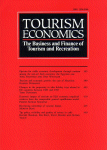Tourism Economics special issue on Economics of tourism and transport, Edited by Dr Neelu Seetaram
Economics of tourism and transport, Edited by Dr Neelu Seetaram
http://www.ingentaconnect.com/content/ip/tec/2016/00000022/00000002;jsessionid=2hehc41kq538i.alice
Dr Neelu Seetaram, Department of Tourism and Hospitality, Faculty of Management, Bournemouth University, Talbot Campus, Dorset House, Poole BH12 5BB, UK. E-mail: nseetaram@bournemouth.ac.uk.
Transportation is an essential component of the tourism system (Leiper, 1990). This system, made up of s everal activities, creates products to satisfy the needs of tourists (Graham et al, 2008). Transportation is vital in this process as it connects the origin to the destination (Page, 2009), and so destinations are highly dependent on the availability of transport. According to Lamb and Davidson (1996), the quality of the transport network in place is an important factor influencing destination choice and it is argued that adequate and efficient transport networks act as catalysts in a destination’s growth and development. In return, booming destinations stimulate investment in transportation networks (Prideaux, 2000; Forsyth, 2006). Conversely, inadequate transport networks deter tourists from visiting a destination, with a resulting negative effect on its competitiveness and potential for growth (Prideaux, 2000).
everal activities, creates products to satisfy the needs of tourists (Graham et al, 2008). Transportation is vital in this process as it connects the origin to the destination (Page, 2009), and so destinations are highly dependent on the availability of transport. According to Lamb and Davidson (1996), the quality of the transport network in place is an important factor influencing destination choice and it is argued that adequate and efficient transport networks act as catalysts in a destination’s growth and development. In return, booming destinations stimulate investment in transportation networks (Prideaux, 2000; Forsyth, 2006). Conversely, inadequate transport networks deter tourists from visiting a destination, with a resulting negative effect on its competitiveness and potential for growth (Prideaux, 2000).
Page (2009) suggests that the relationship between transport and tourism is more complex, arguing that there is a need to create a framework which encourages ‘our understanding of how tourists interact with transport, the process and factors involved and their effect on the travel component of the overall tourism experience’ (Page, 2009, p 18). Lumsdon and Page (2004) explain that, from the tourist’s perspective, transportation serves two key purposes. For the first purpose, which the authors label as ‘transport for tourism’, transportation is only a means to an end: it has no intrinsic value and for the tourist is merely an enabler. It is the economic cost borne by tourists (Gray, 1966) to enable them to derive utility by consuming the sought-after tourism product(s). Demand for transportation, therefore, is derived from the demand for the tourism products that destinations offer. In contrast, travel itself can hold intrinsic value for tourists, making it the focal element of the tourism product (Lumsdon and Page, 2004): examples include luxury cruises and trips on heritage trains such as the Orient Express. Lumsdon and Page (2004) refer to this type of travel as ‘transport as tourism’. In this case, demand for travel ceases to be a derived demand and utility is obtained from the travel itself. Expenditure on the travel, then, is the price paid for the tourism product rather than merely the travel cost, although travel cost will most likely be incurred to reach to the point of embarkation. In spite of the obvious synergies between tourism and transport, until quite recently the economic literature on the two has been bifurcated.
Introduction
pp. 203-206(4)
Author: Seetaram, Neelu